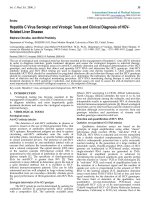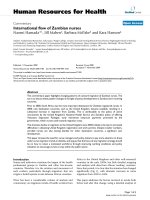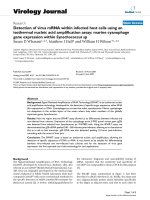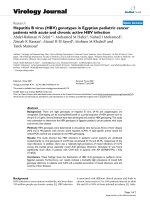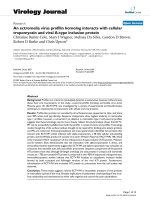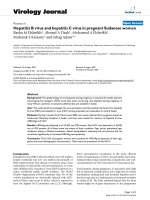Báo cáo sinh học: " Hepatitis B Virus: Inactive carriers" ppt
Bạn đang xem bản rút gọn của tài liệu. Xem và tải ngay bản đầy đủ của tài liệu tại đây (263.48 KB, 5 trang )
BioMed Central
Page 1 of 5
(page number not for citation purposes)
Virology Journal
Open Access
Study protocol
Hepatitis B Virus: Inactive carriers
Sanjeev Kumar Sharma, Nitin Saini and Yogesh Chwla*
Address: Head, Department of Hepatology, PGIMER, Chandigarh, 160012 India
Email: Sanjeev Kumar Sharma - ; Nitin Saini - ;
Yogesh Chwla* -
* Corresponding author
Abstract
Inactive carriers forms the largest group in chronic HBV infected patients. Around 300 million
people are inactive carriers The inactive HBsAg carrier state is diagnosed by absence of HBeAg and
presence of anti-HBe, undetectable or low levels of HBV DNA in PCR-based assays, repeatedly
normal ALT levels, and minimal or no necroinflammation, slight fibrosis, or even normal histology
on biopsy. Inactive cirrhosis may be present in patients who had active liver disease during the
replicative phase of infection. The prognosis of the inactive HBsAg carrier state is usually benign.
Long-term follow- up (up to 18 years) of these carriers has indicated that the vast majority show
sustained biochemical remission and very low risk of cirrhosis or hepatocellular carcinoma (HCC).
Rarely, patients, even noncirrhotics, may develop liver cancer during the inactive HBsAg carrier
state. In addition, approximately 20 to 30% of persons in the inactive HBsAg carrier state may
undergo spontaneous reactivation of hepatitis B during follow-up. Multiple episodes of reactivation
or sustained reactivation can cause progressive hepatic damage and even hepatic decompensation.
Introduction
Hepatitis B virus (HBV) infection and its sequelae are
major global health problems [1]. It is estimated that 400
million people worldwide are HBV carriers [2]. The natu-
ral history of hepatitis B is complex and is influenced by
many factors, including age at infection, viral factors
(HBV genotype, viral mutations, level of HBV replica-
tion), host factors (gender, age, and immune status), and
exogenous factors such as concurrent infection with other
hepatotropic viruses or alcohol. The clinical spectrum of
HBV infection ranges from subclinical to acute sympto-
matic hepatitis or, rarely, fulminant hepatitis during the
acute phase and from the inactive hepatitis B surface anti-
gen (HBsAg) carrier state to chronic hepatitis, cirrhosis,
and its complications during the chronic phase [3,4].
Approximately 15 to 40% of people who develop chronic
HBV infection are expected to progress to cirrhosis and
end-stage liver disease [1]. Difficulties in defining the nat-
ural history of chronic hepatitis B include the indolent
course of the disease, the lack of symptoms during the
early stages, and the heterogeneity of the disease. Under-
standing the natural history and prognosis of hepatitis B
is the basis for disease management and for designing bet-
ter therapeutic strategies.
Hepatitis B Virus
HBV belongs to the family hepdnaviruses. The HBV
genome is a relaxed circular, partially double stranded
DNA of approximately 3,200 base pairs. There are four
partially overlapping open reading frames encoding the
envelope (pre-S/S), core (precore/core), polymerase, and
X proteins [5]. The pre-S/S open reading frame encodes
the large, middle, and small surface glycoproteins. The
Published: 28 September 2005
Virology Journal 2005, 2:82 doi:10.1186/1743-422X-2-82
Received: 30 December 2004
Accepted: 28 September 2005
This article is available from: />© 2005 Chwla; licensee BioMed Central Ltd.
This is an Open Access article distributed under the terms of the Creative Commons Attribution License ( />),
which permits unrestricted use, distribution, and reproduction in any medium, provided the original work is properly cited.
Virology Journal 2005, 2:82 />Page 2 of 5
(page number not for citation purposes)
precore/core open reading frame is translated into precore
polypeptide which is modified in to a soluble protein, the
hepatitis B e antigen (HBeAg), and the nucleocapsid core
protein hepatitis B core antigen (HBc Ag) [5]. The
polymerase protein functions as reverse transcriptase as
well as DNA polymerase. The X protein is a potent trans-
activator and may play role in hepatocarcinogenesis.
Prevalence
Hepatitis B is spread predominantly parenterally, through
intimate personal contact, and perinatally. Individuals at
risk are intravenous drug users, children of mothers with
HBV, men who have sex with men, patients on hemodial-
ysis and those exposed to blood or blood products [6,7].
Approximately 5% of the world's populations are carriers
of HBV, defined as being positive for hepatitis B surface
antigen. HBV is endemic in many areas of the world, such
as Asia, Micronesia, and sub-Saharan Africa as well as in
certain populations in Australia, New Zealand, South
America, the Middle East and the Arctic. An estimated
1.25 million people in the United States are positive for
hepatitis B surface antigen. Fifteen percent to forty percent
of these carriers may develop hepatitis B-related sequelae
in their lifetimes [8-10].
Natural History
Perinatal infection of infants from infected mothers and
horizontal infection early in childhood from exposure to
HBsAg-positive family members are the main routes of
HBV transmission in highly endemic areas, such as South-
east Asia, Africa, the Pacific Islands, and the Arctic. In
regions of low endemicity, such as Western countries,
hepatitis B is primarily a disease of adolescents and adults
as a result of high-risk sexual behavior and injection drug
use. HBV infection is a dynamic process with replicative
and nonreplicative (or low replicative) phases based on
virus-host interaction. The presence of circulating HBsAg,
hepatitis B e antigen (HBeAg), and high levels of serum
HBV DNA characterizes the immunotolerant phase. This
first phase is seen in patients with perinatal infection and
often lasts for decades. During this phase patients have no
symptoms, normal or slightly increased serum alanine
aminotransferase (ALT) levels, and minimal histological
activities, which imply that there is a lack of or a very weak
immune response against the infected hepatocytes.
Experimental results in transgenic mice suggested HBeAg
induces a state of immunological tolerance to HBV in
neonates [11]. During the course of chronic HBV infec-
tion, for unknown reasons, the tolerogenic effect is and
patients may enter the immunoactive phase, which is
associated with a decrease in HBV DNA concentrations
and increased ALT levels and histologic activity, reflecting
immune-mediated lysis of infected hepatocytes. This sec-
ond phase has a variable duration from months to years.
The third low or nonreplicative phase occurs seroconver-
sion from HBeAg to antibody to HBeAg. This phase is usu-
ally preceded by a marked reduction of serum HBV DNA
to levels that are not detectable by hybridization tech-
niques, followed by normalization of ALT levels and reso-
lution of liver necroinflammation. In many patients,
serum HBV DNA remains detectable by the sensitive tech-
nique of polymerase chain reaction (PCR). This phase is
also referred as the inactive HBsAg carrier state [3,4]. The
inactive carrier state may for a lifetime, but a proportion
of patients may undergo subsequent spontaneous or
immunosuppressioninduced reactivation of HBV replica-
tion with reappearance of high levels of HBV DNA with or
without HBeAg seroreversion and a rise in ALT levels [3].
For reasons that are not yet known, replication-competent
HBV variants with mutations in the precore or core pro-
moter regions preventing or down-regulating HBeAg pro-
duction may be selected during or after HBeAg
seroconversion.
Patients who become HBsAg negative and develop anti-
body to HBsAg (anti-HBs) are diagnosed as having
resolved hepatitis B [3,4]. This is an uncommon phenom-
enon in chronic HBV infection. During stage HBV DNA
may still be detectable by PCR in serum and more often in
the liver.[12] In rare cases severe immune suppression,
such as cancer chemotherapy or after organ transplanta-
tion, HBV can be reactivated in patients with resolved
hepatitis B [13].
Clinical spectrum
HBeAg positive Chronic Hepatitis
Patients with HBeAg-positive chronic hepatitis B usually
present in the third or fourth decade of life. Men outnum-
ber women, [14,15] liver damage ranges from mild (24 to
42%) to moderate or severe chronic hepatitis (44 to 63%)
or active cirrhosis (10 to 24%) [16-20]. Chronic hepatitis
B tends to be milder in children. Nevertheless, severe liver
disease including cirrhosis may occur in a small propor-
tion of patients during childhood [21,22]. A key event in
the natural history of HBeAg positive chronic hepatitis is
HBeAg seroconversion. Several studies have shown that
seroconversion with marked reduction of HBV replication
is associated with biochemical and histologic remission of
inflammatory activity in the majority of patients [23-25].
Regression of fibrosis occurs gradually months to years
after HBeAg seroconversion.[26] In longitudinal studies
the observed probability of clearing HBeAg was about
50% and 70% within 5 and 10 years of diagnosis, respec-
tively [23,27-29]. Most studies have found that the mean
annual rate of spontaneous HBeAg seroconversion ranges
from 8 to 15% in children or adults with elevated ALT
[3,4,23-25,29-31,31]. Among Asian, most of whom have
normal ALT, spontaneous HBeAg seroconversion occurs
at a very low rate, less than 2% during the first 3 years of
Virology Journal 2005, 2:82 />Page 3 of 5
(page number not for citation purposes)
age and 4 to 5% in children older than 3 years [32]. Sev-
eral determinants for HBeAg seroconversion have been
reported, including gender, age, ALT level, and more
recently HBV genotypes. Older carriers and females are
more likely to clear HBeAg [33].
Frequent acute exacerbation of hepatitis, reflecting
immune-mediated lysis of HBV-infected hepatocytes with
ALT elevations to more than 10 times ULN and more than
twice the baseline value and with HBV DNA levels rising
before and falling during the flare, precede seroconversion
of HBeAg to anti-HBe. These exacerbations usually last 2
to 4 months [34]. In some cases these spontaneous flares
of hepatitis are not followed by subsequent HBeAg sero-
conversion and can be viewed as an abortive attempt at
seroconversion. These flares of hepatitis are usually
asymptomatic and frequently unrecognized, but some are
accompanied by symptoms of acute hepatitis and rarely,
primarily in patients with cirrhosis or advanced fibrosis,
may lead to hepatic decompensation and even death due
to massive necrosis [34].
HBsAg-negative chronic hepatitis
The diagnosis of HBeAg-negative chronic hepatitis B is
based on the presence of HBsAg for more than 6 months,
undetectable HBeAg, presence of anti-HBe, detectable
serum HBV DNA exceeding 10
5
to 10
6
copies/mL,
increased ALT levels, and hepatic necroinflammation on
histology. Other causes of liver disease, such as superin-
fection with other hepatitis viruses, alcohol abuse, hepa-
totoxic drug use, and autoimmune or metabolic liver
disease, should be excluded [3,4]. The atypical serological
profile is related to the predominance of HBV variants,
which are unable to express HBeAg. The most frequent
variant has a G-to-A change at nucleotide 1896 (G1896A),
which creates a stop codon in the precore region of the
HBV genome and completely abolishes the production of
HBeAg [35]. Other variants include changes in the start
codon of the precore region or a two-nucleotide substitu-
tion (A1762T, G1764A) in the core promoter region,
which reduces precore messenger RNA synthesis and
HBeAg production [36].
Patient with HBeAg negative are older than patients with
HBeAg-positive chronic hepatitis (median 40, range 36–
45 years). Males predominate and data indicate that liver
disease is more active and advanced, minimal or mild
chronic hepatitis is infrequent, and severe necroinflam-
mation is seen in more than 50% patients at diagnosis
[37-39]. In reports from Mediterranean area, 29 to 38%
had cirrhosis at presentation. The older age and the high
rate of advanced liver damage at presentation suggest that
HBeAg-negative chronic hepatitis represents a late phase
in the natural history of chronic HBV infection rather than
de novo infection with HBV variants that do not produce
HBeAg. To further support this concept, a recent long-
term study reported that HBeAg-negative chronic hepatitis
accumulated over time after HBeAg seroconversion with a
cumulative incidence of approximately 25% after 16 years
of follow-up [40]. Thus, the increasing prevalence of
HBeAg-negative. Fluctuation in level of viremia and ALT
are more common and sustained response is rare. Delayed
spontaneous HBsAg clearance has been estimated to occur
at a low rate of 0.5% per year [40].
Inactive HBsAg Carrier State
Inactive carriers forms the largest group in chronic HBV
infected patients. Around 300 million people are inactive
carriers The inactive HBsAg carrier state is diagnosed by
absence of HBeAg and presence of anti-HBe, undetectable
or low levels of HBV DNA in PCR-based assays, repeatedly
normal ALT levels, and minimal or no necroinflamma-
tion, slight fibrosis, or even normal histology on biopsy
[3,4]. Inactive cirrhosis may be present in patients who
had active liver disease during the replicative phase of
infection. The prognosis of the inactive HBsAg carrier state
is usually benign. Long-term follow- up (up to 18 years)
of these carriers has indicated that the vast majority show
sustained biochemical remission and very low risk of cir-
rhosis or hepatocellular carcinoma (HCC) [40-42].
Rarely, patients, even noncirrhotics, may develop liver
cancer during the inactive HBsAg carrier state [40-43]. In
addition, approximately 20 to 30% of persons in the inac-
tive HBsAg carrier state may undergo spontaneous reacti-
vation of hepatitis B during follow-up [29,33,34,40].
Multiple episodes of reactivation or sustained reactivation
can cause progressive hepatic damage and even hepatic
decompensation. HBV reactivation is usually asympto-
matic but on occasion can mimic acute viral hepatitis
[44]. Acute flares of hepatitis should be differentiated
from superinfection with other hepatotropic viruses. As
many as 20 to 30% of these acute exacerbations may be
caused by superinfection with HDV, HCV, or hepatitis A
virus and can be associated with an increased risk of ful-
minant hepatic failure [44]. Some carriers eventually
become HBsAg negative and develop anti-HBs. The inci-
dence of delayed HBsAg clearance has been estimated to
be 1 to 2% per year in Western countries, where HBV
infection is usually acquired in adulthood, but a lower
rate from 0.05 to 0.8% per year in endemic areas, where
HBV infection is mostly acquired perinatally or in early
childhood. Clearance of HBsAg has been reported to be
higher in women than in men and in older than younger
carriers. Prognosis is improved by loss of HBsAg as liver
disease is usually inactive and nonprogressive, but HBsAg
clearance does not completely prevent occurrence of
decompensation or HCC in patients who have already
developed cirrhosis [45,46].
Virology Journal 2005, 2:82 />Page 4 of 5
(page number not for citation purposes)
Change in the terminology of HBV carriers
HBV infection is termed as chronic if it continues to be
HBsAg +ve for ≥6 months. Chronic HBV infection is a
dynamic process with a wide spectrum of spectrum of
affliction. On one hand patients are asymptomatic with
no clinical evidence of liver diseases, while on other being
end-stage cirrhosis and hepatocellular carcinoma. For
many decades the patients were considered to have a
benign, non progression infection and were designated as
hepatitis B "carriers". Probably the word 'carrier' was mis-
takenly chosen for hepatitis B as in true sense, a carrier is
an individual who (i) harbors a specific infectious agent
(ii) has no discernible clinical disease and (iii) serves as a
potential source of infection. For this infection the second
and third points should be looked at carefully. One the
basis of Asian collaborative survey the term 'carrier' was
replaced by the term 'chronic hepatitis B virus infection'
[47,48]. Later on for this infection the term 'Inactive
HBsAg carrier' was adopted [49].
Management of Inactive HBsAg Carrier
Differentiation from chronic HBsAg negative hepatitis B,
requires serial testing of ALT and HBV DNA for one year
before designating carrier state [49]. In subject with inac-
tive carrier state testing of HBV DNA and liver biopsy are
not recommended. Treatment is not recommended as
there is no evidence that available therapy affects HBsAg
status. Family screening with HBsAg and anti-HBs, if neg-
ative vaccinate them and success of vaccination should be
confirmed with anti-HBs testing. Protected sexual inter-
course until partner has developed protective antibodies.
The offspring need active and passive vaccination [4,47].
Use of alcohol should be avoided, possibility of reactiva-
tion or super infection by other viruses and advised if
there is jaundice, malaise or increased fatigue. Regular fol-
low-up at every 6–12 months intervals with ALT [4]. If the
age of the patient is more than 50 yrs family history of
HCC-AFP and ultrasonography every 6–12 monthly
should be done. Universal precaution should be taken
while treating these patients in the hospital. They should
not be allowed to donate the blood or organ or semen. For
pregnant women vaccinate the new born at birth with
active and passive immunization with in 12 hours of the
birth, close monitoring required if undergoing chemo-
therapy or immunosuppressive medication.
References
1. Maddrey WC: Hepatitis B: an important public health issue. J
Med Virol 2000, 61:362-366.
2. Lee WM: Hepatitis B virus infection. N Engl J Med 1997,
337:1733-1745.
3. Lok AS, Heathcote EJ, Hoofnagle JH: Management of hepatitis B:
2000 – summary of a workshop. Gastroenterology 2001,
120:1828-1853.
4. Lok ASF, McMahon BJ: Chronic hepatitis B. Hepatology 2001,
34:1225-1241.
5. Seegar C, Mason WS: Hepattits B virus: the major etiology of
hepatocellular carcinoma. Cancer 1988, 61:9142-56.
6. Margolis HS, Alter MJ, Hadier SC: Hepatitis B: evolving epidemi-
ology and implications for control. Semin Liver Dis 1991,
11:84-92.
7. Beasley RP, Hwang LY, Lee GC, et al.: Prevention of perinatally
transmitted hepatitis B virus infections with hepatitis B
immune globulin and hepatitis B vaccine. Lancet 1983,
2:1099-1102.
8. Lee WM: Hepatitis B virus infection. N Engl J Med 1997,
337:1733-1745.
9. McQuillan GM, Townsend TR, Fields HA, Carrol M, Leahy M, Polk BF:
Seroepidemiology of hepatitis B virus infection in the United
States. Am J Med 1989, 87(suppl 3A):5S-10S.
10. CDC Immunization Practices Advisory Committee (ACIP): Hepati-
tis B Virus: A comprehensive strategy for limiting transmis-
sion in the United States through universal childhood
vaccination. MMWR Morb Mortal Wkly Rep 1991, 40(RR-13):1-25.
11. Milich DR, Chen MK, Hughes JL, Jones JE: The secreted hepatitis
B precore antigen can modulate the immune response to
the nucleocapsid: a mechanism for persistence. J Immunol
1998, 160:2013-2021.
12. Chemin I, Zoulim F, Merle P, et al.: High incidence of hepatitis B
infections among chronic hepatitis cases of unknwon aetiol-
ogy. J Hepatol 2001, 34:471-473.
13. Kawatani T, Suou T, Tajima F, et al.: Incidence of hepatitis virus
infection and severe liver dysfunction in patients receiving
chemotherapy for hematologic malignancies. Eur J Haematol
2001, 67:45-50.
14. Burk RD, Hwang LY, Ho GYF, Shafritz DA, Beasley RP: Outcome of
perinatal hepatitis B virus exposure is dependent on mater-
nal virus load. J Infect Dis 1994, 170:1418-1423.
15. Cacciola I, Cerenzia G, Pollicino T, et al.: Genomic heterogeneity
of hepatitis B virus (HBV) and outcome of perinatal HBV
infection. J Hepatol 2002, 36:426-432.
16. Hoofnagle JH, Dusheiko GM, Seef LB, et al.: Seroconversion from
hepatitis B e antigen to antibody in chronic type B hepatitis.
Ann Intern Med 1981, 94:744-748.
17. Fattovich G, Rugge M, Brollo L, et al.: Clinical, virologic and histo-
logic outcome following seroconversion from HBeAg to
anti-HBe in chronic hepatitis type B. Hepatology 1986,
6:167-172.
18. Moreno-Otero R, Garcia-Monzòn C, Garcia-Sànchez A, et al.: Devel-
opment of cirrhosis after chronic type B hepatitis: a clinico-
pathologic and follow-up study of 46 HBeAg-
positiveasymptomatic patients. Am J Gastroenterol 1991,
86:560-564.
19. Zarski JP, Marcellin P, Cohard M, et al.: Comparison of anti-HBe-
positive and HBe-antigen-positive chronic hepatitis B in
France. J Hepatol 1994, 20:636-640.
20. Di Marco V, Lo Iacono O, Cammà C, et al.: The long-term course
of chronic hepatitis B. Hepatology 1999, 30:257-264.
21. Chang MH, Hsu HY, Hsu HC, et al.: The significance of spontane-
ous hepatitis B e antigen seroconversion in childhood: with
special emphasis on the clearance of hepatitis B e antigen
before 3 years of age. Hepatology 1995, 22:1387-1392.
22. Bortolotti F, Jara P, Crivellaro C, et al.: Outcome of chronic hep-
atitis B in Caucasian children during a 20-year observation
period. J Hepatol 1998, 29:184-190. CDC. Hepatitis B virus: a com-
prehensive strategy for limiting transmission in the United States
through universal child vaccination. Recommendation of the Immuni-
zation Practice Advisory Committee (ACIP). MMWR 1991;40:RR-
13:1–25
23. Realdi G, Alberti A, Rugge M, et al.: Seroconversion from hepati-
tis B e antigen to anti-HBe in chronic hepatitis B virus infec-
tion. Gastroenterology 1980, 79:195-199.
24. Hoofnagle JH, Dusheiko GM, Seef LB, et al.: Seroconversion from
hepatitis B e antigen to antibody in chronic type B hepatitis.
Ann Intern Med 1981, 94:744-748.
25. Fattovich G, Rugge M, Brollo L, et al.: Clinical, virologic and histo-
logic outcome following seroconversion from HBeAg to
anti-HBe in chronic hepatitis type B. Hepatology 1986,
6:167-172.
26. Fong TL, Di Bisceglie AM, Gerber MA, Waggoner JG, Hoofnagle JH:
Persistence of hepatitis B virus DNA in the liver after loss of
HBsAg in chronic hepatitis B. Hepatology 1993, 18:1313-1318.
27. Yuen MF, Hui CK, Cheng CC, et al.: Long-term follow-up of inter-
feron alfa treatment in Chinese patients with chronic hepa-
Publish with BioMed Central and every
scientist can read your work free of charge
"BioMed Central will be the most significant development for
disseminating the results of biomedical research in our lifetime."
Sir Paul Nurse, Cancer Research UK
Your research papers will be:
available free of charge to the entire biomedical community
peer reviewed and published immediately upon acceptance
cited in PubMed and archived on PubMed Central
yours — you keep the copyright
Submit your manuscript here:
/>BioMedcentral
Virology Journal 2005, 2:82 />Page 5 of 5
(page number not for citation purposes)
titis B infection: the effect on hepatitis B e antigen
seroconversion and the development of cirrhosis-related
complications. Hepatology 2001, 34:139-145.
28. McMahon BJ, Holck P, Bulkow L, Snowball M: Serologic and clinical
outcomes of 1536 Alaska natives chronically infected with
hepatitis B virus. Ann Intern Med 2001, 135:759-768.
29. Bortolotti F, Cadrobbi P, Crivellaro C, et al.: Long-term outcome
of chronic type B hepatitis in patients who acquire hepatitis
B virus infection in childhood. Gastroenterology 1990, 99:805-810.
30. Wong DKH, Cheung AM, O'Rourke K, et al.: Effect of alpha-inter-
feron treatment in patients with hepatitis B e antigen posi-
tive chronic hepatitis B. A meta-analysis. Ann Intern Med 1993,
119:312-323.
31. Vajro P, Migliaro F, Fontanella A, Orso G: Interferon: a meta-anal-
ysis of published studies in pediatric chronic hepatitis B. Acta
Gastroenterol Belg 1998, 61:219-223.
32. Chang MH, Sung JL, Lee CY, et al.: Factors affecting clearance of
hepatitis B e antigen in hepatitis B surface antigen carrier
children. J Pediatr 1989, 115:385-390.
33. Lok ASF, Lai CL, Wu PC, Leung EKY, Lam TS: Spontaneous hepa-
titis B e antigen to antibody seroconversion and reversion in
Chinese patients with chronic hepatitis B virus infection. Gas-
troenterology 1987, 92:1839-1843.
34. Perillo RP: Acute flares in chronic hepatitis B: the natural and
unnatural history of an immunologically mediated liver dis-
ease. Gastroenterology 2001, 120:1009-1022.
35. Hadziyannis SJ, Vassilopoulos D: Hepatitis B e antigennegative
chronic hepatitis B. Hepatology 2001, 34:617-624.
36. Chan HLY, Leung NWY, Hussain M, Wong ML, Lok ASF: Hepatitis
B e antigen-negative chronic hepatitis B in Hong Kong. Hepa-
tology 2000, 31:763-768.
37. Fattovich G, Farci P, Rugge M, et al.: Randomized controlled trial
of lymphoblastoid interferon alfa in patients with chronic
hepatitis B who lacked hepatitis B e antigen. Hepatology 1992,
15:584-589.
38. Lampertico P, Del Ninno E, Manzin A, et al.: A randomized, con-
trolled trial of a 24-month course of interferon alfa 2b in
patients with chronic hepatitis B who had hepatitis B virus
DNA without hepatitis B e antigen in serum. Hepatology 1997,
26:1621-1625.
39. Tassopoulos NC, Volpes R, Pastore G, et al.: Efficacy of lamivudine
in patients with hepatitis B e antigen negative hepatitis B
virus DNA-positive (precore mutant) chronic hepatitis B.
Lamivudine Precore Mutant Group. Hepatology 1999,
29:889-896.
40. Hsu YS, Chien RN, Yeh CT, et al.: Long-term outcome after
spontaneous HBeAg seroconversion in patients with chronic
hepatitis B. Hepatology 2002, 35:1522-1527.
41. De Franchis R, Meucci G, Vecchi M, et al.: The natural history of
asymptomatic hepatitis B surface antigen carriers. Ann Intern
Med 1993, 118:191-194.
42. Bellentani S, Dal Molin G, Miglioli L, et al.: Natural history of HBV
infection: a 9 years follow-up of the Dionysos cohort. J Hepatol
2002, 36(Suppl 1):228.
43. Fattovich G, Giustina G, Realdi G, Corrocher R, Schalm SW: Long-
term outcome of hepatitis B e antigen positive patients with
compensated cirrhosis treated with interferon alfa. Hepatol-
ogy 1997, 26:1338-1342.
44. Tassopoulos NC, Papaevangelou GJ, Sjogren MH, et al.: Natural his-
tory of acute hepatitis B surface antigen-positive hepatitis in
Greek adults. Gastroenterology 1987, 92:1844-1850.
45. Fattovich G, Giustina G, Sanchez-Tapias J, et al.: Delayed clearance
of serum HBsAg in compensated cirrhosis B: relation to
interferon alpha therapy and disease prognosis. Am J Gastroen-
terol 1998, 93:896-900.
46. Huo TI, Wu JC, Lee PC, et al.: Sero-clearance of hepatitis B sur-
face antigen in chronic carriers not necessarily implies a
good prognosis. Hepatology 1998, 28:231-236.
47. Sarin Sk: Summary and recommendations of single theme
conferences on hepatitis B and C: Indian association for
study of the liver (INASL). J gastro hepatol 2002, 17:S197-S203.
48. Sarin SK, Sathpathy SK, Chauhan R: Hepatitis B e-antigen nega-
tive chronic hepatitis B. J gastro hepatol 2002, 17:S311-S321.
49. EASL international consensus conference on hepatitis B.
Journal of Hepatology 2003, 39:S3-S25.


